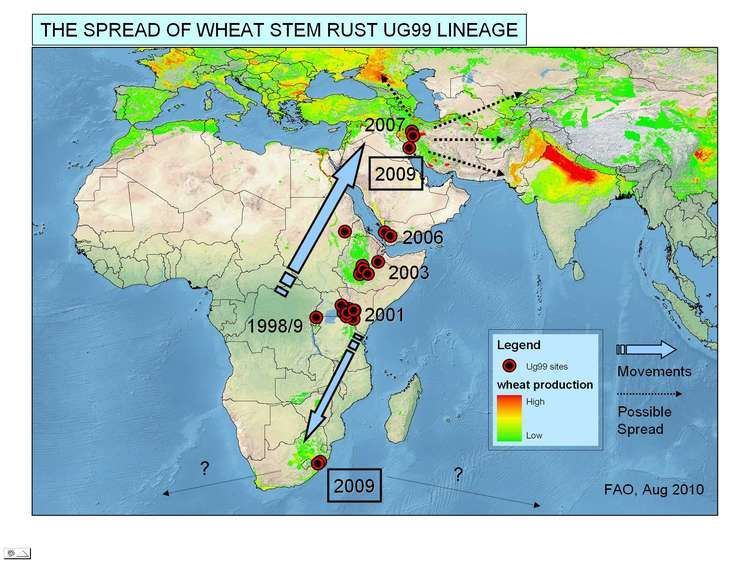Kingdom Fungi Subclass Incertae sedis Rank Race | Phylum Basidiomycota Order Pucciniales | |
 | ||
Higher classification Puccinia graminis f. sp. tritici Similar Stem rust, Rust, Puccinia, Puccinia striiformis, Aegilops | ||
Ug99 wheat rust threatens world wheat crop
Ug99 is a lineage of wheat stem rust (Puccinia graminis f. sp. tritici), which is present in wheat fields in several countries in Africa and the Middle East and is predicted to spread rapidly through these regions and possibly further afield, potentially causing a wheat production disaster that would affect food security worldwide. It can cause up to 100% crop losses and is virulent against many resistance genes which have previously protected wheat against stem rust.
Contents
- Ug99 wheat rust threatens world wheat crop
- 80 crop failure ug99 fungus
- Gene resistance
- Races
- Timeline
- In film and television
- References
Although Ug99-resistant varieties of wheat do exist, a screen of 200 000 wheat varieties used in 22 African and Asian countries found that only 5-10% of the area of wheat grown in these countries consisted of varieties with adequate resistance.
The original race of Ug99, which is designated as 'TTKSK' under the North American nomenclature system, was first characterised in Uganda in 1999 (hence the name Ug99) and has since been detected in Kenya, Ethiopia, Eritrea, Sudan, Yemen, Iran, Uganda, Tanzania, Mozambique, Zimbabwe, South Africa, and Egypt. There are now 11 known races of Ug99. They are all closely related and are believed to have evolved from a common ancestor, but differ in their virulence/avirulence profiles and the countries in which they have been detected.
80 crop failure ug99 fungus
Gene resistance
Ug99 and its variants differ from other strains of the Black Stem Rust (BSR) pathogen due to their ability to overcome resistance genes in wheat that have been durable against the BSR pathogen for decades. These resistant Sr genes, of which 50 are known, confer different resistance to stem rust. The virulence in Uganda was associated with Sr31 and is specific to Ug99. The massive losses of wheat that have occurred have been devastating, but in recent years the wheat rust epidemic has been effectively controlled through selection and breeding for these Sr genes. The United States Department of Agriculture (USDA) researchers are testing genes to substantiate their Ug99 resistance, which will ultimately aid in developments of wheat varieties that will be able to fight off the rust. USDA researchers have stated that resistance has been identified in spring wheat land races and that they are now studying winter wheat land races where resistance is more probable. Due to the fact that the screening of the winter races is more challenging, results from the studies are not expected for another five to seven years. In addition to the research being conducted by the USDA, The United Kingdom’s Department for International Development (DFID), along with The Bill & Melinda Gates Foundation, announced in February 2011 that they will by granting $40 million to a global project led by Cornell University to combat deadly strains of Ug99. The five-year grant to the Durable Rust Resistance in Wheat (DRRW) project will support attempts to identify new resistance genes as well as reproduce and distribute rust resistant wheat seeds to farmers.
Races
There are 11 races of Ug99, which (under the North American nomenclature system) have the designations TTKSK, TTKSF, TTKST, TTTSK, TTKSP, PTKSK, PTKST, TTKSF+, TTKTT, TTKTK, and TTHSK. They are all closely related and are believed to have evolved from a common ancestor.
TTKSK was the first Ug99 race to be characterised. Like most Ug99 races, and unlike other stem rust varieties, it is virulent against the Sr gene Sr31. It is known to be present in Uganda, Kenya, Ethiopia, Sudan, Yemen, Iran and Tanzania.
TTKST, discovered in Kenya in 2006 was the first Ug99 race found to be virulent against the Sr gene Sr24. TTKST is now the predominant stem rust race in Kenya.
Timeline
1993:
There is some evidence that race TTKSK may have been present in Kenya.
1998:
Severe stem rust infections observed in Uganda. Ug99 identified, characterised as having virulence on Sr31 and named.
2000:
TTKSF detected in South Africa.
2001:
TTKSK detected in Kenya.
2003:
TTKSK detected in Ethiopia.
2006:
TTKSK detected in Sudan and Yemen.
TTKST, a new variant of Ug99 with virulence to Sr24, detected in Kenya.
2007:
TTTSK detected in Kenya.
TTKSP detected in South Africa.
PTKSK detected in Ethiopia.
PTKST detected in Ethiopia.
2008:
FAO announced the presence of Ug99 in Iran.
PTKST detected in Kenya.
2009:
TTKSK detected in Tanzania.
TTKST detected in Tanzania.
TTTSK detected in Tanzania.
TTKSF detected in Zimbabwe.
PTKSK detected in Kenya.
PTKST detected in South Africa.
2010:
TTKST detected in Eritrea.
PTKST detected in Eritrea.
PTKST detected in Mozambique.
PTKST detected in Zimbabwe.
TTKSF+ detected in South Africa.
TTKSF+ detected in Zimbabwe.
2014:
TTKTK confirmed in Egypt.
In film and television
The Leverage (TV series) of 27 June 2010 (USA) aired an episode called "The Inside Job" that had part of its storyline the introduction of Ug99 into the world's wheat system to cause destruction of the world supply except for Ug99 resistant strains.
